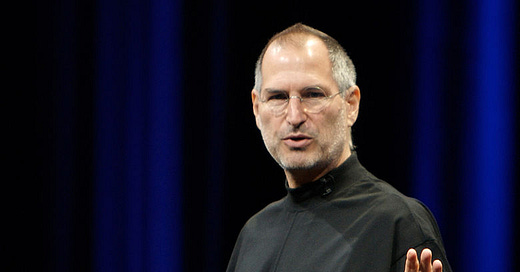Steve Jobs Can Help You Become a Better Data Scientist. Here’s How
Steal these techniques that made Jobs great.
I’m a big Steve Jobs fan. I watched many of his keynote presentations, read his biography, and even watched how he worked with his team back in the 80s (through YouTube videos, of course).
Besides the products he and his team developed and the industries he changed, I admired him as a communicator.
He could turn any complex and dull topic into exciting and memorable stories that anyone could understand. This is what you can steal from Jobs—his communication skills.
In this article, I’m not going to explain why communication skills are important for data scientists (I already wrote an entire article about this), but focus on the techniques you can steal from Jobs, which you’d probably need in your next presentation.
Story over slides
If you ever watched a Steve Jobs presentation, you’ve probably noticed, besides his black turtleneck, that his slides don’t have many words (let alone bullet points!). Most of the time, he included only a couple of words or a picture in his slides to encapsulate the main idea of his speech.
Jobs focused on the story rather than on the slides because it’s not the slides that capture the imagination of an audience but the story.
In the book The Presentation Secrets of Steve Jobs, the author mentions that Jobs started on a paper or whiteboard to sketch the structure of every presentation.
Jobs used many techniques to have great presentations. Here are some techniques that you can use in your next data science presentation:
Metaphors and analogies: Turn complex concepts into something anyone can understand. Here’s how Jobs described the computer, “What a computer is to me is the most remarkable tool that we have ever come up with. A bicycle for our minds”
Make your own headlines: Create sentences that will stick to your audience. It has to be something short and memorable. In the introduction of the first iPhone, Jobs didn’t let the press create the headline for his product, but he made his own saying: “Today Apple reinvents the phone”
Develop key messages: Create key messages and points to support your ideas. In the introduction of the first iPhone, Jobs said “The problem with the smartphone (in 2007) is that they’re not so smart, and they’re not so easy to use” But he didn’t just say that and moved on, but supported his idea explaining how obsolete the plastic QWERTY keyboard (that smartphones back then included) would get in a few years.
Selling your ideas
When it comes to selling your ideas, you have to be very careful about the words you use and how you say them.
The way you describe things
You’d rarely hear Jobs using buzzwords in a presentation. These words might make you look smarter when talking with your peers, but they’ll make non-technical people confuse.
Another technique he used quite often (and that you need to use) was giving meaning to the numbers. Every presentation has numbers that we obtain after doing some analysis. Behind these numbers there are a lot of technical concepts, so we have to “dress up the numbers” by removing all the technical stuff off our minds and coming up with practical applications.
In the introduction of the first iPad, Jobs, instead of saying how many mAh the iPad had, said,
“It has 10 hours of battery life, It means, I can take a flight from San Francisco to Tokyo and watch video the whole way on one charge”
When describing the first iPod, instead of talking about the number of GB the device had, he said,
“This amazing little device holds 1000 songs right in my pocket”
A few people would understand the technical specifications, but if you describe the benefits they have in their life/business, you’ll be speaking the same language.
The way you speak
In every presentation, Jobs showed charisma and passion for what he did. Showing his passion at work and in every presentation helped him gain many followers.
Also, the way he said things was important.
He raised and lowered the pitch of his voice to add drama, highlight something, and make the presentations more entertaining. He added pauses to let ideas sink in. He played with the rate of his speech to deliver key messages at a slow speech rate.
All of this is something you only learn by practicing a lot, which leads us to our next point.
Practice is needed, If you want to sound spontaneous
One common misconception about Jobs is that he was a natural-born communicator. That’s not true at all! Actually, he had to work hard on it.
Steve Wozniak (Apple co-founder) told CNBC that Jobs wasn’t always a marketing and communication guru. Jobs had to develop those skills to compensate for not being a skilled computer engineer.
Even when Jobs became a great communicator, he had to rehearse every presentation until he got it right.
In the book The Presentation Secrets of Steve Jobs, the author mentions that Jobs had to prepare weeks before a keynote. Sometimes he’d spend hours for only 5 minutes of presentation. He looked for excellence, so he took care of even little details like properly syncing the slides with his speech.
Jobs made his presentations look effortlessly, but behind all of that, there was a lot of work. Remember, practice is needed if you want to sound spontaneous.




